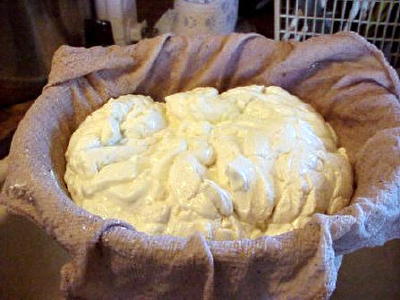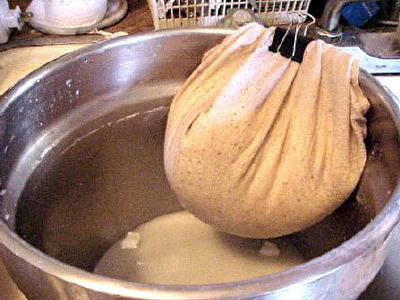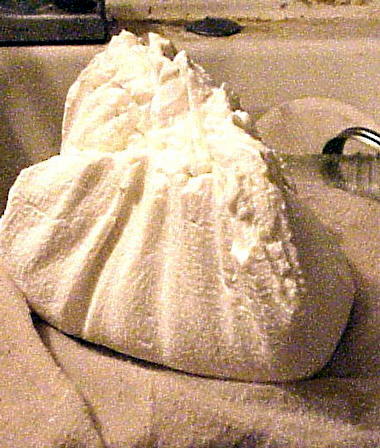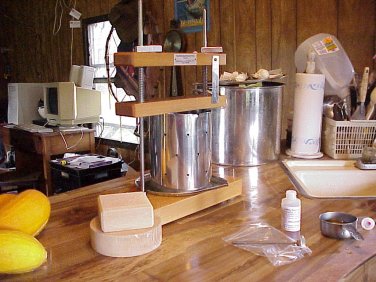FareShare Recipe Exchange Group
|
Home
| Chat | Recipes
| Metrics | Cooking
Temperatures | Links |
||
|
Photo Album From Martha: Easy Goat Milk Cheese |
||
|
In case anyone is interested, I made goat cheese (fresh chevre)
last week and took photos of the stages it went through. This
cheese has a wonderful melting quality. I've been put on a low salt
diet and most 'storeboughten' foods are very high in salt, cheese
especially. The basic steps of what milk goes thru to turn into cheese. |
|
|
|
1. While
I have milk on the stove, waiting for the
temperature to come up from refrigerator range to
'ok to work' range, I'll measure out the
rennet. See note. I use
the little cap on the rennet tube itself and
measure about 15 capfuls (maybe 30 drops) to add
to less than 1/4 cup of cool water. The water is
just to help distribute the rennet throughout the
milk for even curding. (Left)
Note: Rennet is the dried extract of rennin. This enzyme is responsible for most of the milk coagulation that takes place. Traditionally rennet was derived from animals. However, some vegetables juices and extracts are used as rennin and modern advances in science have enabled microorganisms to produce enzymes that mimic animal rennet. Rennet can come from animal, vegetable or microbial sources. |
|
2. Goat milk is unique in that cream doesn't separate out of the milk as readily as cow's milk. In about 5 - 8 days, there will be a thin cream line. This old milk is shaken up to gather the cream again and poured up into fresh milk and allowed to get to 86F before adding the rennet to the whole pot of milk. Added rennet (milk clotting enzyme) to milk. Forms a clean break curd in about an hour. Cut the curd into large soft cubes. (Right) |
|
|
|
3. On the stove in a double boiler
system, monitor the temperature closely.
(Left)
For rennet-started cheese, keep it at between 86F and 100F for about an hour to set the curd. Notice the curds have shrunk back into the whey here.
|
| 4. Curds have been bagged and drained of the initial whey.
(Right) The cheese still has a great deal of whey left in it at this point. This is where salt or other seasonings are added.
Rennet is just to curd the cheese. Starter culture determines what the cheese is going to be when it grows up. (gives it flavor and certain textures.) Blue cheese is a mold spore that is ripened on the cheese and Swiss cheese is gas from mold that ripens within the cheese to cause it to 'blow apart' to make the holes.
|
 |
 |
5. Draining the curd.
(Left)
It's own weight is usually sufficient to drain the excess whey for a soft fresh cheese. (Because it will have whey inside the cheese ball, this doesn't keep more than a week.) |
| 6. A finished cheese.
(Right)
At this point it could be pressed hard for an aged cheese or blended with herbs for a soft 'cream cheese dip'. Rennet started cheeses (not taken to over 100F temperatures) should have melting qualities. Vinegar started cheeses will not melt. |
 |
|
|
7. The leftover (8
pounds) whey. (Left)
Rennet cheeses can have other uses made with the whey. Vinegar cheeses can not. You can make a delicious ricotta out of the leftover whey from any rennet-started cheese. There is usually enough residual 'clotting action' to sufficiently curd up another small batch of fresh cheese the next day if you add a quart of fresh milk back to the whey and warm it gradually back up. This usually makes a very nice ricotta, but it's highly perishable due to the 'aged' whey in it. You can use vinegar to curd milk at very high temperatures (just below boiling), and you'll get farmers cheese or cottage cheese curds. This is ok, but it has little flavor on it's own and lacks elasticity and any meltability. It is great as 'mock' tofu or for fried cheese snacks.
|
| 8. This
batch was 'flabbier' than the last one. It was
raining when I set it to curd, that's about the
only thing different. (Right)
To press a cheese, you don't want to start with maximum pressure, easing into it allows the whey in the middle of the cheese to be squeezed out, not back into the cheese. I'm having to take my press apart every hour or so and turn the cheese to keep it pressing evenly and to keep the holes in the press from clogging up and preventing whey from being released. I'm up to about 5 lbs in this picture and it's been turned twice. Each time the cheese shrinks and I have to add more followers to the press. I may end up with a cheese pancake, but hey, it's only milk and a little rennet. |
|
 |
9. Since I have all my gear out (Left) I'm going to see if I have enough fresh milk to make a whey cheese (farmer's cheese or ricotta). Otherwise the whey will get dumped out to the pigs. |
| Questions? Contact Martha August 2002 | |
Cooking
and Food Information Index
|
Disclaimer: The operators of the FareShare Website are not responsible for the content or practice of any website to which we link for your convenience. |
Art Guyer operates this project.
Home | Chat | Recipes | Metrics | Cooking Temperatures | Links